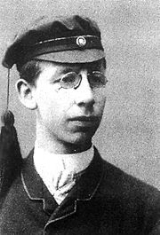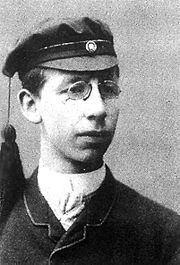
Johan Vaaler
Encyclopedia

Johan Vaaler was a Norwegian
Norway
Norway , officially the Kingdom of Norway, is a Nordic unitary constitutional monarchy whose territory comprises the western portion of the Scandinavian Peninsula, Jan Mayen, and the Arctic archipelago of Svalbard and Bouvet Island. Norway has a total area of and a population of about 4.9 million...
inventor and patent clerk
Patent clerk
A patent examiner is an employee, usually a civil servant, working at a patent office. Major employers of patent examiners are the European Patent Office , the United States Patent and Trademark Office and the Japan Patent Office.-Duties:Patent examiners review patent applications to determine...
, from 1892 office manager of Bryns Patentkontor in Kristiania. He has often erroneously been identified with the invention of the common paper clip
Paper Clip
"Paper Clip" is a 1995 episode of The X-Files television series. It was the second episode broadcast in the show's third season. Paper Clip concludes the story regarding the agents' possession of a digital tape containing government secrets on extraterrestrials.- Plot :Continuing from the previous...
, known to all office employees for more than a hundred years. He was born in Aurskog
Aurskog
Aurskog is a former municipality in Akershus county, Norway. The administrative centre was Aursmoen.Aurskog was the location of the Battle of Toverud. The parish of Urskog was established as a municipality January 1, 1838 . On 1 July 1919 the district of Blaker was separated to form a municipality...
as the son of a farmer, and died in Kristiania.
Vaaler designed a kind of paper clip in 1899 and applied for a German patent on November 12 of that year. It was granted on June 6, 1901 . He also filed an application for a United States
United States
The United States of America is a federal constitutional republic comprising fifty states and a federal district...
patent on January 9, 1901. The U.S. patent was granted on June 4, 1901.
Unknown to Vaaler, a more functional and practical paper clip was already in production by the British
United Kingdom
The United Kingdom of Great Britain and Northern IrelandIn the United Kingdom and Dependencies, other languages have been officially recognised as legitimate autochthonous languages under the European Charter for Regional or Minority Languages...
"Gem Manufacturing Company Ltd", but not yet marketed in Norway. His design was less perfect because it lacked the two full loops of the wire. Vaaler probably succeeded in having his design patented abroad, despite the existence of a better product, because patent authorities at that time were quite liberal and rewarded any marginal modification of earlier inventions. Several types of paper clips had been patented in the United States since 1867, but the "Gem" type was not then (and has never been) patented. As an employee of Bryns patent office in Kristiania, Vaaler was familiar with patent legislation and procedures in Norway. His reasons for applying abroad are unknown, but it is possible that he had an exaggerated confidence in his invention and saw the need to secure the commercial rights internationally. Also, he may have been aware that Norwegian inventors would meet difficulties on the small home market. Quite soon he must have had the disappointment of his life when he was confronted by the "Gem", which was probably introduced in Norway during his own lifetime. He is not known to have tried to contact potential manufacturers in Norway or abroad, and this lack of initiative seems to confirm that he soon learned that a superior clip already existed. His patent was allowed to expire quietly, without a single one of his many proposed designs having ever been manufactured. Meanwhile, the "Gem" conquered the world, including his own country. The Norwegian fish hook
Fish hook
A fish hook is a device for catching fish either by impaling them in the mouth or, more rarely, by snagging the body of the fish. Fish hooks have been employed for centuries by fishermen to catch fresh and saltwater fish. In 2005, the fish hook was chosen by Forbes as one of the top twenty tools...
manufacturer O. Mustad & Søn AS of Gjøvik
Gjøvik
is a town and a municipality in Oppland county, Norway. The administrative centre of the municipality is the town of Gjøvik.In 1861, the village of Gjøvik in the municipality of Vardal was granted town status and was separated from Vardal to form a separate municipality...
has produced Gem-type paper clips since 1928.
Vaaler's alleged invention of the paper clip became known in Norway after World War II
World War II
World War II, or the Second World War , was a global conflict lasting from 1939 to 1945, involving most of the world's nations—including all of the great powers—eventually forming two opposing military alliances: the Allies and the Axis...
and found its way into some encyclopedias. Events of that war contributed greatly to the mythical status of the paper clip as a national symbol. During the resistance to the German
Germany
Germany , officially the Federal Republic of Germany , is a federal parliamentary republic in Europe. The country consists of 16 states while the capital and largest city is Berlin. Germany covers an area of 357,021 km2 and has a largely temperate seasonal climate...
occupation during World War II, after pins or badges bearing national symbols or the initials of exiled King Haakon VII
Haakon VII of Norway
Haakon VII , known as Prince Carl of Denmark until 1905, was the first king of Norway after the 1905 dissolution of the personal union with Sweden. He was a member of the House of Schleswig-Holstein-Sonderburg-Glücksburg...
were banned, Norwegians began to wear paper clips in their lapels as a symbol of resistance to the occupiers and local Nazi authorities. The clips were meant to denote solidarity and unity ("we are bound together"). Their symbolism was even more obvious because paper clips are called "binders" in Norwegian. Their presumed Norwegian origin was not generally known at that time, but when that widely believed story was added to the war-time experience of many patriots, it strengthened their status as national symbols.
Literature
- Henry Petroski, The Evolution of Useful things (1992); ISBN 0-679-74039-2 (with a history of the evolution of paper clip design)

